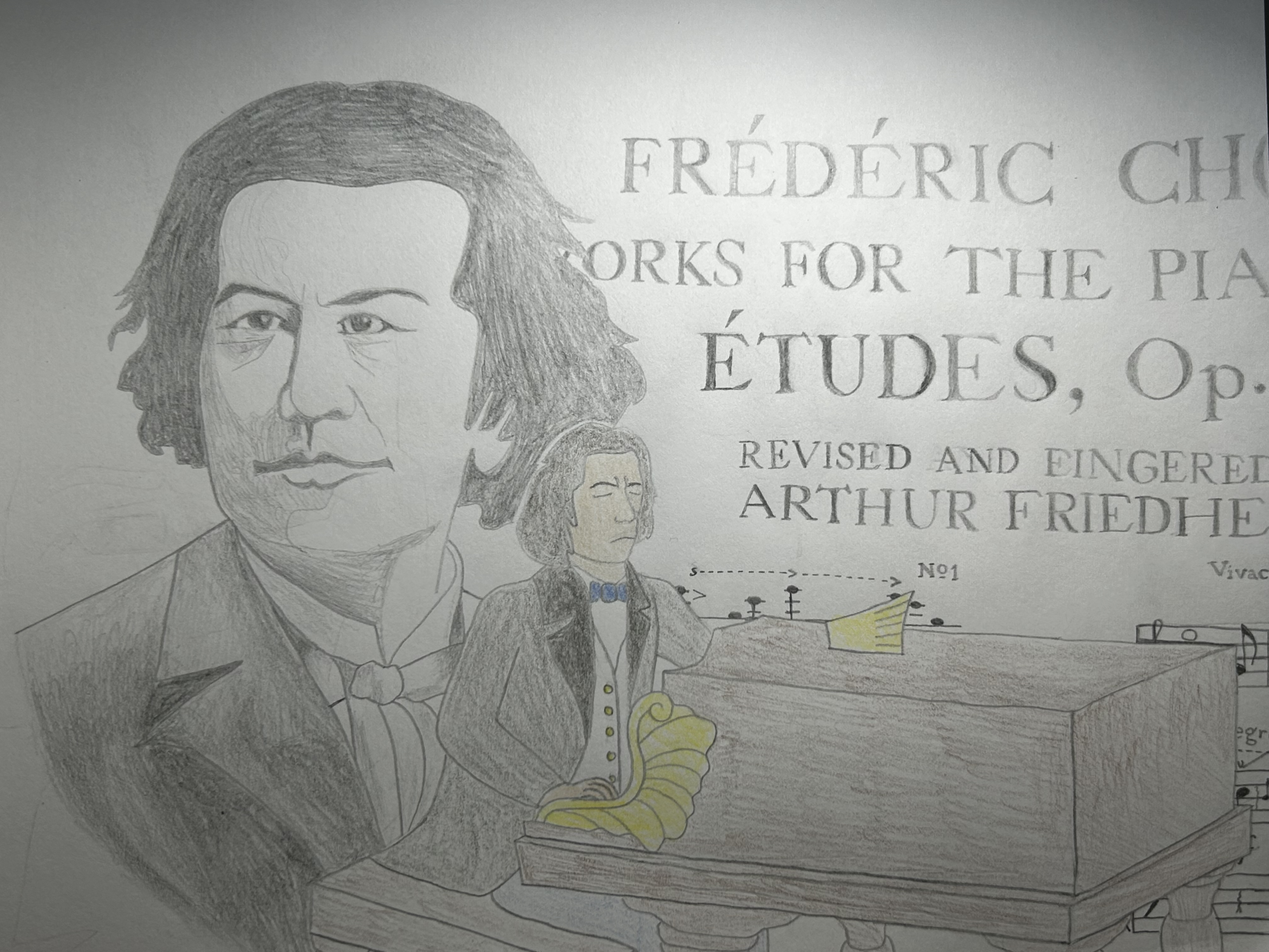Chopin is one of the most widely praised composers and performers, not just in classical music, but music as a whole. His works from the Romantic era combine technical brilliance, emotional depth, and virtuosic techniques; Chopin’s impact on music is felt even to this day. But what was his life story, and what can people take away from his compositions today?
Frederic Chopin was born March 1, 1810, in Żelazowa Wola, Duchy of Warsaw, now known as Poland. He was originally born Fryderyk Chopin, but after fleeing to France during the Polish Uprising in 1830, he changed his name to the French spelling, Frederick Chopin. His father, Nickolas, was a French emigrant teacher, violinist, and flautist, while his mother, Justine Krzyżanowska, was a Polish pianist. Chopin showed interest in music at a young age, composing pieces such as the Polonaise in G Minor in 1817 when he was a mere seven years old. He showed high musical talent when he was young, with his early works, such as his Variations, Op. 2, for piano and orchestra on Mozart’s La ci darem la mano—written when he was 17—spreading through Europe, earning praise from renowned composer Robert Schumann, who famously said, “Allgemeine musikalische Zeitung,” or “Hats off, gentlemen! A genius!” Later, he would establish relationships with other notable composers, such as Franz Liszt, Vincenzo Bellini, and Felix Mendelssohn.
When he moved to Paris, Chopin struggled to gain attention due to the people’s preference for works of composers such as Franz Schubert and Ludwig van Beethoven. However, he managed to gain the support of the aristocratic Rotschild family, who gave him access to the private salons that enjoyed his delicate style. Through these opportunities, he became both a recitalist and teacher for the high social class of Paris. The financial support allowed him to enjoy a good quality of life and compose pieces such as Nocturnes of Opp. 9 and 15, the Scherzo in B-flat minor, Op. 31, and the Sonata in B-flat minor, Op. 35, which includes the famous “Funeral March.” He would also go on to compose other works in his first years in Paris, such as the 12 Études, Op. 25—dedicated to Comtesse Marie d’Agoult—and the Ballade in G minor, Op. 23 (my personal favorite of his works).
Chopin engaged in multiple romantic relationships, including with French novelist Amantine Lucile Aurore Dupin, known by her pen name George Sand, who supported Chopin when he was diagnosed with tuberculosis. After his recovery, Chopin lived with Sand in Nohant, France, where he would spend the next seven years composing masterpieces, some of which are considered to be his best works: Sonata in B Minor, Opus 55 Nocturnes, and Opus 56 Mazurkas. His creative growth, combined with his growing understanding of the publishing industry, allowed Chopin to become financially successful and be able to sustain an elegant lifestyle. Thus, this time period, (1839 to 1846) is arguably Chopin’s peak of his creative output.
This virtuosic peak of Chopin’s performance is juxtaposed by his condition in the mid-1840s. His decline was characterized by erratic behavior, poor health, and his deteriorating relationship with Sand, which ended in 1848. He would perform his final public appearance on November 16, 1848 at Guildhall, despite being stricken by his reappearing tuberculosis. However, his poor health did not deteriorate the quality of his last performance: One witness said that Chopin obtained the energy to play “like an angel.” He would die a year later from tuberculosis.
But what made Chopin such an influential composer of classical music? Ultimately, it was his innovative approach to performance technicality, along with his infusion of nationalism into music, which shaped his legacy as one of the greatest, most influential pianists of the late Romantic period. Chopin developed new techniques in finger positioning, pedal usage, and keyboard manipulation in general, elevating his music into distinction. Moreover, his creativity in musical style, form, and harmony inspired other composers of the Romantic era, such as Franz Liszt, Claude Debussy, Gabriel Fauré, and Richard Strauss. He also synthesized nationalism into his work, infusing cultural elements of Polish music—such as folk melodies and rhythms—into his piano works, especially exemplified by his Polonaises and Mazurkas. Thus, his music drew attention to the Russian occupation of Poland; it was a call for the return of Polish independence and sovereignty. The pro-independence symbolism led the music to be banned by German Nazi soldiers.
Chopin was also an artist, who exemplified key tenets of Romanticism in his works. The emotional depth, rich harmonies, and dynamic contrasts allowed him to portray a wide range of emotions in his works, while his new piano techniques and infusion of Polish culture created an individualistic body of work. This directly corresponds with the Romantic interest in emotional expression and individualism, demonstrating his ability to effectively translate the artistic styles of the era into wordless music.
Even after his death, new pieces by Chopin are still being released. This is due to the fact that Chopin didn’t release all of his works, meaning that some of it has not yet been heard by the general public. For instance, Chopin wrote a waltz that wasn’t released until 200 years after his death. Newly released pieces such as this one still send ripples through the music world, showing just how impactful his works are to this day.


